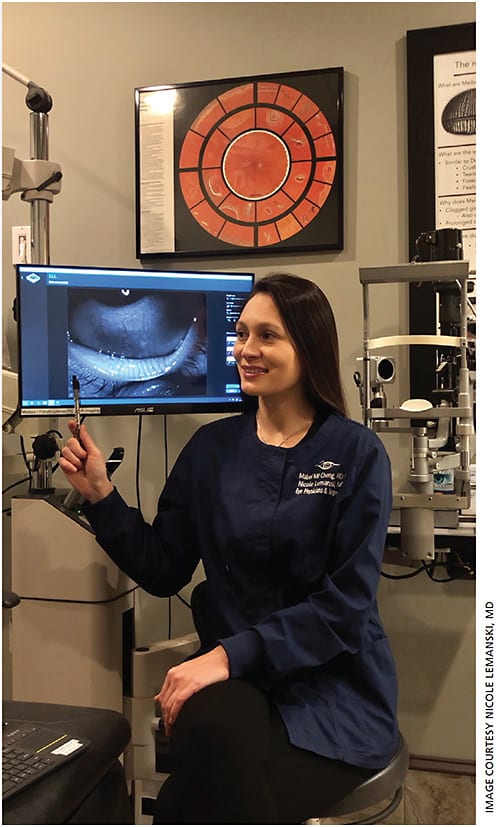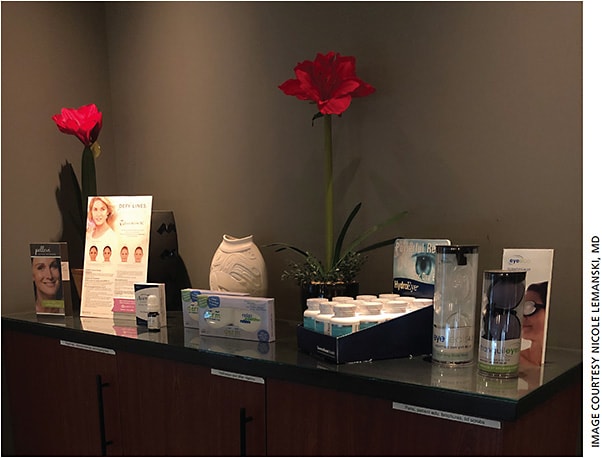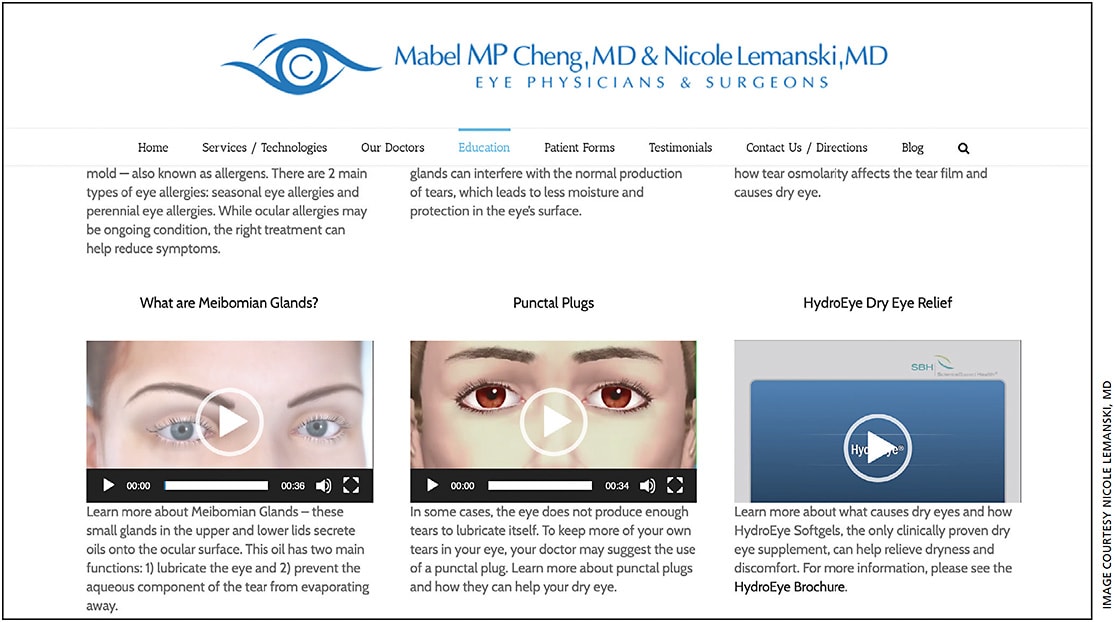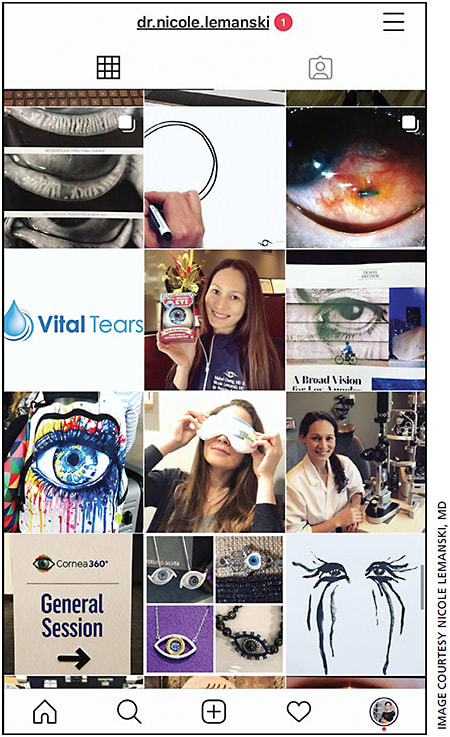Roughly 16 million people in the United States carry the diagnosis of dry eye, according to a 2017 article in the American Journal of Ophthalmology by Farrand KF et al. The true number, however, may be higher. Many people, whether they experience symptoms or not, go about their daily lives unaware that their ocular surface is less than ideal.
“Dry eye” is a nonspecific umbrella term that can mean different things to different individuals. Some patients describe a sandy, gritty sensation, others burning and stinging. Some mention that their eyes are “tired” or tear, and they have blurry vision. Others insist that they feel nothing unusual at all. The outcomes, though, are similar: when untreated, alteration of the tear film ultimately leads to inflammation and ocular surface disease (OSD).
Management of these ocular surface conditions should not be thought of as a niche or obscure practice. As eye-care providers, we see people with these issues daily, and it is up to us to pick up on the subtle clues in order to make a timely dry eye diagnosis and initiate preventive measures and proper therapy. Doing so improves patient outcome and satisfaction and ultimately helps build a practice with a reputation for excellence in dry eye management.
As a cornea specialist, dry eye/OSD comprises more than 50% of my practice. That being said, fellowship training is not required to accurately diagnose and treat the majority of these patients; one just needs to keep an open mind and use a methodical approach.
When building a dry eye-focused practice, consider the following elements.
WILLINGNESS AND AWARENESS
The first step in building a successful dry eye practice is for the provider to be to be aware of the impact and importance of the disease. The provider needs to be willing to take the time to adapt and incorporate new therapies, treatment algorithms and modalities into their practice.
OSD patients often have a long list of prior treatments and providers and may carry binders full of extensive notes on past experiences. Making these experiences work for you and aligning with your patient is the most important first step. Each new patient visit is an opportunity to provide a fresh start. We use data from the past, ask directed questions and incorporate new data from that day’s exam to offer a fresh perspective on the situation.
I like to directly address the patient’s disease burden, their quality of life and how they have dealt with the issues in the past. Taking the time to listen and recognize dry eye as a legitimate group of similar but distinct diseases provides the patient validation and emotional relief. While it may take a little extra chair time, the reward is worth it.
EDUCATION
Before you can help your patients, you need to educate yourself and your staff. As a general ophthalmologist, you should familiarize yourself with the different etiological classifications of dry eye. Also, you must stay current on new modalities and therapies to continue to provide your patients optimal help. I recommend you:
- Read educational materials. Purchase and review a well-written textbook, such as “Ocular Surface Disease: Cornea, Conjunctiva and Tear Film” by Edward J. Holland, Mark J. Mannis and W. Barry Lee.
- Stay up to date. Read peer reviewed articles from high impact journals, and attend lectures on ocular surface disease and dry eye. Smaller scale meetings increase your ability to have one-on-one conversations with experts.
- Educate your office staff. Set aside time to educate technicians and staff on OSD and the conditions you are treating. Understanding of pathophysiology of the disease and why certain testing and therapies are utilized will make your technicians’ job more gratifying and will ultimately make your team stronger.
- Test therapies on yourself and your staff. What is it like to swallow nutritional supplement pills? Are some dropper bottles more difficult than others? Do gel tear drops blur your vision? Are warm compress masks easy to use? How do you wash the base of your eyelashes? I find it helpful to be able to tell my patients what to expect and things that I have encountered myself while trialing a therapy.
- Familiarize yourself with offerings from local and national compounding pharmacies. Know where to get what you need when you need it.
PATIENT WORKUP SCHEDULING
When scheduling ocular surface patients’ first encounters, allow for a little more time than a standard exam. You not only need to establish a relationship with the patient and learn their history, but you often need extra time for testing and to understand what therapies have and have not worked.
First, we ask patients to complete a dry eye questionnaire, like the ocular surface disease index (OSDI). During the encounter, the OSDI acts as a springboard for further discussion and directed testing. Then, we do a complete history and comprehensive exam that includes refraction and dilation. Technicians complete baseline testing and a comprehensive history, as in a normal encounter, and ask some dry eye specific questions regarding supplemental oxygen, CPAP usage, rheumatologic history, medications and prior therapies.
Other aspects that contribute to a longer than typical workup can include tear osmolarity testing, meibography and slit lamp imaging. All imaging helps with patient education and compliance, as well (Figure 2).

TREATMENT PLAN AND PRODUCTS
Many patients have multiple etiologies for their signs and symptoms. The challenge is to construct a customized plan that addresses their issues that they can still manage. If possible, I like to start with over-the-counter treatments and lifestyle changes first, such as warm compresses, lid hygiene and omega fatty acids supplements.
As a convenience to your patients, consider offering the items you trust and recommend in your office, perhaps at a lower price point than they can find online (Figure 1). I keep a stock of heated masks, blepharitis lid cleansers, moisture sleeping masks and omega nutritional supplements. While we sell products at our office, I tell patients that I do not endorse any single product; I only recommend what I believes works best. For instance, we offer HydroEye (ScienceBased Health) because it includes omega fatty acids GLA and EPA/DHA for dry eye. We provide literature, when possible, on products we sell in the office and encourage patients to look elsewhere and compare. Many times they come back just to pick up the product.

For those who need it, I offer in-office treatments like heated manual meibomian gland expression, Prokera amniotic membrane placement and thermocautery. Also, I have a number of patients on serum tears and a few who require compounded drops.
I provide succinct written instructions indicating what the therapy is and how it works. While going over the treatment plan, I remind patients that any new therapy is a commitment from them and things do not change overnight. Creating these realistic expectations helps patients to stick with a therapy instead of abandoning it.
When considering these therapies, keep in mind that you don’t need to add them all to your arsenal at once — you can implement one thing at a time.
MARKETING
Marketing doesn’t have to be gimmicky. You want to create awareness of dry eye in your community, and you want people to know that you are accessible and available to listen and help. Make it easy for new patients to come and see you.
Consider the following methods of marketing:
- Develop a user-friendly website. We have most of our educational videos and forms available for streaming and download (Figure 3). Take the time to be involved in your web design; showcase diagnostic equipment, testing and technologies that you offer, and highlight procedures and therapies. First and foremost, we want our patients to know that we are there to provide education and care, not to sell them a specific product. We include product literature for every product that we believe in, but do not have obvious photos of products on our website. You can also provide education on dry eye and your services on your social media pages (Figure 4). Ultimately, the goal is to let patients know they should come to you for diagnosis and treatment, not self-treat from a website or phone app.

Figure 3. Make educational videos available to stream on your practice website. 
Figure 4. Dr. Lemanski uses her Instagram page to market dry eye services and provide education. - Share your knowledge in the community. Help colleagues understand that healthier ocular surfaces produce better surgical outcomes. Take the opportunity to host your own lecture on dry eye and ocular surface disease. Local groups will be excited to include you in local health fair events. Community and senior centers, Lions Clubs chapters or your area’s low vision association are good avenues to investigate and places to host wellness seminars. You can also team up with city or state ophthalmology or optometric societies and inquire about being included in their educational meetings.
- Establish a trusted referral network. Who can you help, and who can help you? Go out into the community and visit optometry and ophthalmology practices, primary care doctors and rheumatologists. Introduce yourself to the staff and the doctors. Hand out business cards that list services you provide, and highlight ocular surface disease/dry eye. All practices have many patients suffering from dry eye, and it is helpful for them to have a person to refer to. This is not only a marketing tool, but it also builds camaraderie and a collegial atmosphere and gives providers and patients peace of mind.
- Ask patients to share their experiences. Nothing beats word of mouth advertising. When you help patients who have been unable to find a doctor who was willing to listen or to recognize their dry eye as a valid condition, they will be happy to talk you up to their friends and family.
WE CAN HELP OUR PATIENTS LIVE BETTER
Recognizing dry eye/ocular surface disease as a condition that can impact quality of life is the first step to helping our patients find relief. Education of yourself, your staff and your patients is the foundation for success and will help make your practice a one-stop shop for care.
Implementing a dry eye focused protocol with directed testing and treatment therapy is an opportunity to improve the lives of your patients while enhancing the scope and success of your practice on multiple levels. OM










